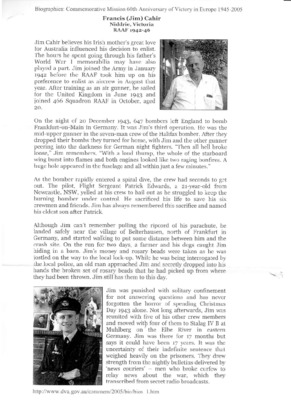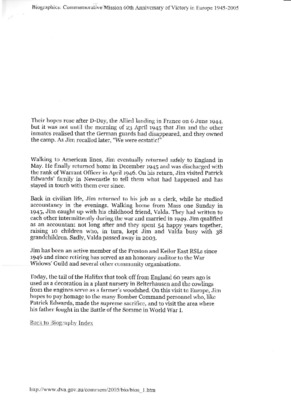Short biography of Jim Cahir
Title
Short biography of Jim Cahir
Description
A biography of Jim covering the shooting down of his aircraft and the start of his confinement as a prisoner of war.
Temporal Coverage
Spatial Coverage
Language
Format
Two typewritten sheets
Publisher
Rights
This content is available under a CC BY-NC 4.0 International license (Creative Commons Attribution-NonCommercial 4.0). It has been published ‘as is’ and may contain inaccuracies or culturally inappropriate references that do not necessarily reflect the official policy or position of the University of Lincoln or the International Bomber Command Centre. For more information, visit https://creativecommons.org/licenses/by-nc/4.0/ and https://ibccdigitalarchive.lincoln.ac.uk/omeka/legal.
Contributor
Identifier
MCahirFS419441-160608-080001,
MCahirFS419441-160608-080002
MCahirFS419441-160608-080002
Transcription
Biographies: Commemorative Mission 60th Anniversary of Victory in Europe 1945-2005
Francis (Jim) Cahir
Niddrie, Victoria
RAAF 1942-46
Jim Cahir believes his Irish mother’s great love for Australia influenced his decision to enlist. The hours he spent going through his father’s World War I memorabilia may have also played a part. Jim joined the Army in January 1942 before the RAAF took him up on his preference to enlist as aircrew in August that year. After training as an air gunner, he sailed for the United Kingdom in June 1943 and joined 466 Squadron RAAF in October, aged 20.
[black and white head and shoulders photograph of Francis Cahir]
On the night of 20 December 1943, 647 bombers left England to bomb Frankfurt-on-Main in Germany. It was Jim’s third operation. He was the mid-upper gunner in the seven-man crew of the Halifax bomber. After they dropped their bombs they turned for home, with Jim and the other gunner peering into the darkness for German night fighters. “Then all hell broke loose,” Jim remembers. “With a loud thump, the whole of the starboard wing burst into flames and both engines looked like two raging bonfires. A huge hole appeared in the fuselage and all within just a few minutes.”
As the bomber rapidly entered a spiral dive, the crew had seconds to get out. The pilot, Flight Sergeant Patrick Edwards, a 21-year-old from Newcastle, NSW, yelled at his crew to bail out as he struggled to keep the burning bomber under control. He sacrificed his life to save his six crewmen and friends. Jim has always remembered this sacrifice and named his eldest son after Patrick.
Although Jim can’t remember pulling the ripcord of his parachute, he landed safely near the village of Belterhausen, north of Frankfurt in Germany, and started walking to put some distance between him and the crash site. On the run for two days, a farmer and his dogs caught Jim hiding in a barn. Jim’s money and rosary beads were taken as he was jostled on the way to the local lock-up. While he was being interrogated by the local police, an old man approached Jim and secretly dropped into his hands the broken set of rosary beads that he had picked up from where they had been thrown. Jim still has them to this day.
[black and white head and shoulders photograph of Francis Cahir in his uniform]
Jim was punished with solitary confinement for not answering questions and has never forgotten the horror of spending Christmas Day 1943 alone. Not long afterwards, Jim was reunited with five of his other crew members and moved with four of them to Stalag IV B at Muhlberg on the Elbe River in eastern Germany. Jim was there for 17 months but says it could have been 17 years. It was the uncertainty of their indefinite sentence that weighed heavily on the prisoners. They drew strength from the nightly bulletins delivered by ‘news couriers’ – men who broke curfew to relay news about the war, which they transcribed from secret radio broadcasts.
[page break]
Their hopes rose after D-Day, the Allied landing in France on 6 June 1944, but it was not until the morning of 23 April 1945 that Jim and the other inmates realised that the German guards had disappeared, and they owned the camp. As Jim recalled later, “We were ecstatic!”
Walking to American lines, Jim eventually returned safely to England in May. He finally returned home in December 1945 and was discharged with the rank of Warrant Officer in April 1946. On his return, Jim visited Patrick Edwards’ family in Newcastle to tell them what had happened and has stayed in touch with them ever since.
Back in civilian life, Jim returned to his job as a clerk, while he studied accountancy in the evenings. Walking home from Mass one Sunday in 1945, Jim caught up with his childhood friend, Valda. They had written to each other intermittently during the war and married in 1949. Jim qualified as an accountant not long after and they spent 54 happy years together, raising 10 children who, in turn, kept Jim and Valda busy with 38 grandchildren. Sadly Valda passed away in 2003.
Jim has been an active member of the Preston and Keilor East RSLs since 1946 and since retiring has served as an honorary auditor to the War Widows’ Guild and several other community organisations.
Today, the tail of the Halifax that took off from England 60 years ago is used as a decoration in a plant nursery in Belterhausen and the cowlings from the engines serve as a farmer’s woodshed. On this visit to Europe, Jim hopes to pay homage to the many Bomber Command personnel who, like Patrick Edwards, made the supreme sacrifice, and to visit the area where his father fought in the Battle of the Somme in World War I.
[underlined] Back to Biography Index [/underlined]
Francis (Jim) Cahir
Niddrie, Victoria
RAAF 1942-46
Jim Cahir believes his Irish mother’s great love for Australia influenced his decision to enlist. The hours he spent going through his father’s World War I memorabilia may have also played a part. Jim joined the Army in January 1942 before the RAAF took him up on his preference to enlist as aircrew in August that year. After training as an air gunner, he sailed for the United Kingdom in June 1943 and joined 466 Squadron RAAF in October, aged 20.
[black and white head and shoulders photograph of Francis Cahir]
On the night of 20 December 1943, 647 bombers left England to bomb Frankfurt-on-Main in Germany. It was Jim’s third operation. He was the mid-upper gunner in the seven-man crew of the Halifax bomber. After they dropped their bombs they turned for home, with Jim and the other gunner peering into the darkness for German night fighters. “Then all hell broke loose,” Jim remembers. “With a loud thump, the whole of the starboard wing burst into flames and both engines looked like two raging bonfires. A huge hole appeared in the fuselage and all within just a few minutes.”
As the bomber rapidly entered a spiral dive, the crew had seconds to get out. The pilot, Flight Sergeant Patrick Edwards, a 21-year-old from Newcastle, NSW, yelled at his crew to bail out as he struggled to keep the burning bomber under control. He sacrificed his life to save his six crewmen and friends. Jim has always remembered this sacrifice and named his eldest son after Patrick.
Although Jim can’t remember pulling the ripcord of his parachute, he landed safely near the village of Belterhausen, north of Frankfurt in Germany, and started walking to put some distance between him and the crash site. On the run for two days, a farmer and his dogs caught Jim hiding in a barn. Jim’s money and rosary beads were taken as he was jostled on the way to the local lock-up. While he was being interrogated by the local police, an old man approached Jim and secretly dropped into his hands the broken set of rosary beads that he had picked up from where they had been thrown. Jim still has them to this day.
[black and white head and shoulders photograph of Francis Cahir in his uniform]
Jim was punished with solitary confinement for not answering questions and has never forgotten the horror of spending Christmas Day 1943 alone. Not long afterwards, Jim was reunited with five of his other crew members and moved with four of them to Stalag IV B at Muhlberg on the Elbe River in eastern Germany. Jim was there for 17 months but says it could have been 17 years. It was the uncertainty of their indefinite sentence that weighed heavily on the prisoners. They drew strength from the nightly bulletins delivered by ‘news couriers’ – men who broke curfew to relay news about the war, which they transcribed from secret radio broadcasts.
[page break]
Their hopes rose after D-Day, the Allied landing in France on 6 June 1944, but it was not until the morning of 23 April 1945 that Jim and the other inmates realised that the German guards had disappeared, and they owned the camp. As Jim recalled later, “We were ecstatic!”
Walking to American lines, Jim eventually returned safely to England in May. He finally returned home in December 1945 and was discharged with the rank of Warrant Officer in April 1946. On his return, Jim visited Patrick Edwards’ family in Newcastle to tell them what had happened and has stayed in touch with them ever since.
Back in civilian life, Jim returned to his job as a clerk, while he studied accountancy in the evenings. Walking home from Mass one Sunday in 1945, Jim caught up with his childhood friend, Valda. They had written to each other intermittently during the war and married in 1949. Jim qualified as an accountant not long after and they spent 54 happy years together, raising 10 children who, in turn, kept Jim and Valda busy with 38 grandchildren. Sadly Valda passed away in 2003.
Jim has been an active member of the Preston and Keilor East RSLs since 1946 and since retiring has served as an honorary auditor to the War Widows’ Guild and several other community organisations.
Today, the tail of the Halifax that took off from England 60 years ago is used as a decoration in a plant nursery in Belterhausen and the cowlings from the engines serve as a farmer’s woodshed. On this visit to Europe, Jim hopes to pay homage to the many Bomber Command personnel who, like Patrick Edwards, made the supreme sacrifice, and to visit the area where his father fought in the Battle of the Somme in World War I.
[underlined] Back to Biography Index [/underlined]
Collection
Citation
“Short biography of Jim Cahir,” IBCC Digital Archive, accessed July 26, 2024, https://ibccdigitalarchive.lincoln.ac.uk/omeka/collections/document/20109.
Item Relations
This item has no relations.


